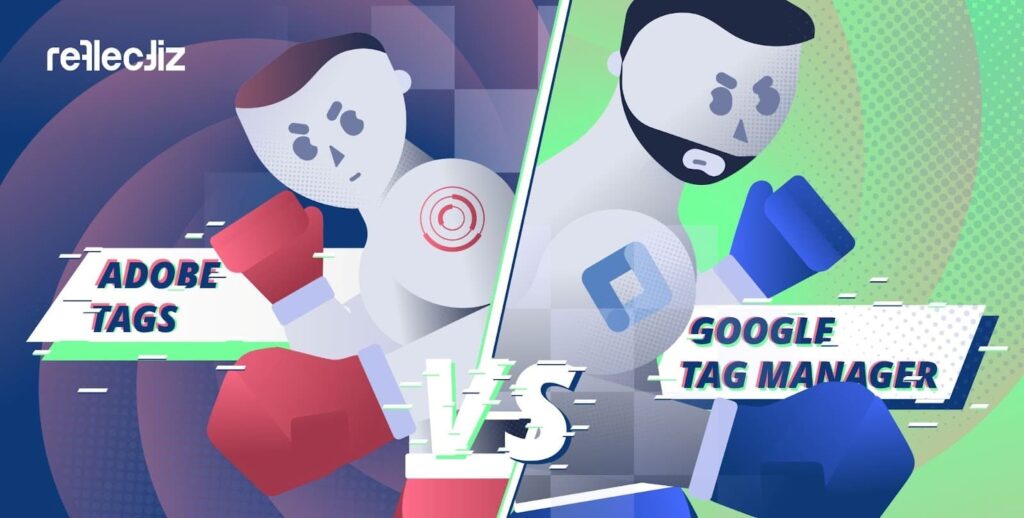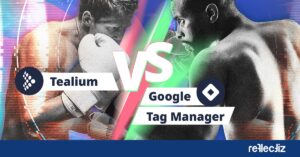Adobe Tags vs. Google Tag Manager: A Security-Focused Comparison

Battle of of the Tag Managers – Part 1: Adobe Tags vs Google Tag Manager
Tag management systems (TMS) are crucial for deploying tracking codes (“tags”) that provide essential insights into user interactions, empowering marketing and analytics teams to react quickly and optimize campaigns.
Among TMS platforms, Adobe Experience Platform Tags (Adobe Tags) and Google Tag Manager (GTM) are prominent. This article offers a head-to-head comparison of Adobe Tags vs Google Tag Manager — their features, security, ease of use, performance, pricing, support, and integrations, with particular attention to security considerations.
Core Features and Functionalities: Adobe Tags vs Google Tag Manager
When comparing Adobe Tags and Google Tag Manager, understanding the nuances in their terminology and core concepts is paramount. Adobe Tags refers to a website or application as a “Property,” analogous to GTM’s “Container,” both serving as the primary organizational unit for managing tags and configurations. Data points are “Data Elements” in Adobe Tags and “Variables” in GTM. GTM separates “Tags” (tracking codes) and “Triggers” (conditions for firing tags), while Adobe combines them into “Rules.” GTM is known for its user-friendly interface, pre-built tag templates, and ease of use, whereas Adobe offers more complex customization for users with higher technical expertise.
Security Landscape: A Deep Dive into Data Privacy, Access Controls, and Vulnerabilities
Both Google Tag Manager and Adobe Tags incorporate features aimed at ensuring data privacy and security, but they approach it with different nuances.
Google Tag Manager Security Features
Google emphasizes its commitment to user privacy through its privacy policy and has obtained ISO 27001 certification for GTM, indicating adherence to recognized security standards. GTM also includes consent mode features to manage tag behavior based on user consent, crucial for complying with regulations like GDPR and CCPA. This consent mode is designed to give website visitors more control over their data, allowing them to choose whether or not certain tags are fired based on their consent preferences. It’s a key feature for businesses operating in regions with stringent privacy laws.
Adobe Tags Security Features
Adobe Experience Platform, including Adobe Tags, places a strong emphasis on data governance and privacy, offering features for consent management and data usage policies. Adobe Tags specifically integrates with consent management solutions to facilitate the implementation of consent strategies. Adobe’s approach focuses on providing enterprises with the tools to manage data privacy at scale, aligning with the complex requirements of large organizations.
User Access Control in GTM and Adobe Tags
Google Tag Manager: Granular Permissions
In terms of user access controls, Google Tag Manager offers granular permissions at both the account and container levels, allowing for controlled access and collaboration. Administrators can assign different levels of access to team members based on their roles, ensuring that only authorized personnel can make changes to tag configurations. This is crucial for preventing unauthorized modifications that could compromise data collection or introduce security vulnerabilities.
Adobe Tags: Comprehensive Rights Management
Adobe Tags also provides robust rights management, offering comprehensive control over organizing access. A key distinction is Adobe’s historical focus on access controls, with older Adobe systems noted for their strong environmental controls compared to GTM. This highlights Adobe’s emphasis on providing fine-grained control over user permissions, a critical feature for large organizations with complex security requirements.
Security Risks with GTM Misconfigurations
However, as with any powerful tool, GTM can also present security risks if not configured properly. Misconfigurations can lead to vulnerabilities, such as the deployment of malicious code or credit card skimming scripts. For a real-world example of how these risks can manifest, check out this case study on GTM security, which illustrates how GTM was exploited by hackers due to misconfigurations, highlighting the importance of proper tag management and security practices.
Mitigating Risks in Google Tag Manager
It’s important to acknowledge that while both platforms offer security features, they are not immune to potential misuse. GTM, for instance, has been exploited to deploy malicious code like credit card skimmers. To mitigate such risks, GTM offers a “Tag Blocking” feature, allowing administrators to define specific tags or tag types that cannot be fired. This feature adds an extra layer of security by preventing the execution of potentially harmful code. Additionally, the use of custom HTML tags in GTM requires careful management, as they can potentially be a vector for Cross-Site Scripting (XSS) attacks if not secured properly. XSS attacks occur when malicious scripts are injected into websites, potentially stealing user data or compromising website functionality.
Adobe Tags Security-by-Design Principles
Adobe emphasizes security-by-design principles for its Experience Platform, including data encryption in transit and at rest, and follows the Adobe Secure Product Lifecycle (SPLC). Adobe Tags supports Content Security Policy (CSP) and Subresource Integrity (SRI) to further enhance website security by preventing cross-site scripting attacks and ensuring the integrity of loaded scripts. CSP allows website administrators to control which resources (e.g., scripts, stylesheets) can be loaded by the browser, reducing the risk of XSS attacks. However, implementing CSP effectively requires careful configuration, especially when using Adobe-managed hosting. Inline scripts, for example, need to be managed using nonces or by allowing ‘unsafe-inline’, each with its own security implications.
CSP and Inline Scripts in Adobe Tags
Configuring Content Security Policy (CSP) in Adobe Tags can be challenging, especially when dealing with inline scripts, which CSP typically restricts to prevent cross-site scripting (XSS) attacks. To address this, Adobe users should implement nonces or hashes for inline scripts instead of using the less secure ‘unsafe-inline’ directive. This ensures that only trusted scripts are executed while maintaining the integrity of the security policy. Additionally, Adobe provides tools within its Experience Platform to help manage CSP, allowing for granular control over security settings, which can help mitigate common issues such as conflicts with dynamically injected scripts.
A common issue arises when third-party services or dynamically injected scripts violate CSP. To resolve this, ensure that all trusted domains are whitelisted in the policy and reduce reliance on inline scripts by using server-side tagging through Adobe Experience Platform Event Forwarding. This method offloads much of the dynamic script handling to the server, improving security and reducing the need for complex inline script management. By following these best practices, users can balance security with functionality when working with Adobe Tags and CSP.
Challenges with Implementing SRI in Adobe Tags
SRI ensures that files fetched from CDNs have not been tampered with. it’s important to note that implementing SRI with Adobe Tags requires self-hosting and manual updates to the embed code with each new build. This process can be complex and may not be practical for all users. Note that this limitation is due to the dynamic nature of tag management systems, which makes SRI challenging to implement in general.
Data Residency Considerations: Adobe Tags vs Google Tag Manager
Data residency refers to the geographical location where data is stored and processed. This is an increasingly important consideration due to various data privacy regulations (e.g., GDPR, CCPA) that may require data to be stored and processed within specific regions.
Here’s a comparison of data residency considerations in both tag management systems:
Google Tag Manager (GTM):
- Client-Side Tagging: GTM itself, in its traditional client-side implementation, primarily facilitates the collection and transmission of data to various vendor platforms. GTM doesn’t inherently store significant amounts of user data. Therefore, data residency concerns are mainly focused on where the vendor platforms (e.g., Google Analytics, marketing platforms) that receive data from GTM store and process that data.
- You need to configure the data processing locations within each of these individual vendor platforms according to their own data residency policies.
- GTM offers features like IP anonymization that can help with compliance before data leaves the browser.
- Server-Side Tagging (ssGTM): This is where data residency becomes a more direct concern within the GTM ecosystem.
- With ssGTM, you deploy a server-side container on a cloud platform (like Google Cloud Platform). You choose the geographical region where this container and its associated data processing occur.
- This allows you to select data center locations that align with your data residency requirements (e.g., choosing a European data center for EU user data).
- You have more control over where the initial data processing happens before it’s forwarded to third-party vendors.
- Multi-Region Deployment: ssGTM on platforms like Google Cloud allows for multi-region deployments to improve performance and potentially further align with data residency needs by processing data closer to the user’s location.
Adobe Tags:
- Client-Side Tagging: Similar to client-side GTM, Adobe Tags primarily manages the deployment of client-side code that sends data to various Adobe and non-Adobe platforms. The actual data storage and processing residency is largely determined by the configurations within those destination platforms (e.g., Adobe Analytics, Adobe Experience Platform).
- You need to configure data processing regions within each Adobe Experience Cloud application and any other third-party tools integrated through Adobe Tags.
- Adobe provides tools and settings within its platform to manage data privacy and consent.
- Server-Side Tagging (via Adobe Experience Platform Event Forwarding): Adobe offers server-side tagging through its Event Forwarding capability within the Adobe Experience Platform (AEP).
- When using Event Forwarding, data is sent to the Adobe Experience Platform Edge Network, which has data centers in various regions globally (e.g., North America, Europe, APAC).
- Upon provisioning your Adobe Experience Platform instance, you can designate the regional data center(s) where the data ingested into AEP will be sent for storage.
- This allows you to choose regions that meet your data residency obligations.
- The Edge Network then processes and forwards data to downstream destinations based on your configurations.
- Adobe emphasizes data governance and provides features within AEP to manage data usage and comply with regulations.
Key Differences and Considerations:
- Direct Control vs. Platform Responsibility: With GTM server-side, you have more direct control over the underlying cloud infrastructure and the region you choose. With Adobe’s Event Forwarding, you rely on the data center locations offered by the Adobe Experience Platform Edge Network.
- Ecosystem Integration: Adobe’s server-side tagging is tightly integrated with the Adobe Experience Cloud, and data residency choices are made within the context of the AEP infrastructure. GTM server-side is more independent and can be deployed on various cloud providers.
- Configuration Focus: In both, you need to configure the data processing locations. For client-side tagging, this primarily happens within the destination platforms. For server-side, the initial processing location is a key configuration within the tag management system’s server-side offering.
- Transparency: Both platforms provide information about their data center locations. Adobe explicitly allows customers to designate the regional data center for their AEP data. GTM server-side gives you the flexibility to choose your cloud provider’s regions.
- Compliance Features: Both platforms offer features to aid in data privacy compliance, such as consent management integrations and the ability to control what data is sent to third parties. However, the specific features and how they relate to data residency might differ.
In summary:
Both GTM (especially with server-side tagging) and Adobe Tags (with Event Forwarding) acknowledge and address data residency considerations. They provide mechanisms to control where data is initially processed and, in the case of server-side implementations, offer choices regarding data center locations. The specific implementation and the level of direct control over infrastructure vary between the two platforms. Ultimately, users of both systems need to carefully configure their setups and understand the data residency policies of all integrated vendor platforms to ensure compliance with relevant regulations.
Security Implications: Open vs. Closed Ecosystems
The open ecosystem of Google Tag Manager (GTM) offers flexibility but introduces security considerations due to its extensibility through custom HTML and JavaScript tags. This openness can increase the attack surface if not carefully managed with strict user permissions and regular audits for malicious code.
Adobe Tags (Launch) operates within a more controlled, albeit still extensible, environment tightly integrated with the Adobe Experience Cloud. While offering robust security features within its ecosystem, its “closed” nature regarding core functionality might limit independent security scrutiny compared to GTM’s wider community.
Ultimately, the security of both platforms relies heavily on diligent user management, regular audits, and adherence to security best practices. The choice between them doesn’t inherently dictate security, but rather shifts the focus of responsibility.
Additional Considerations
While security is paramount, other factors influence the choice between Adobe Tags and Google Tag Manager:
- User Experience and Implementation: Google Tag Manager is generally easier to use and implement, especially for those with less technical expertise. Adobe Tags offers more advanced features but has a steeper learning curve.
- Performance Impact: Both platforms are designed to minimize the impact on website loading speed through asynchronous loading.
- Cost Analysis: Google Tag Manager has a free version, while Adobe Tags is part of the Adobe Experience Cloud, which is a paid service.
- Support and Documentation: Google Tag Manager benefits from extensive community support, while Adobe provides official support resources and certified consultants.
- Integration Ecosystem: Google Tag Manager integrates well with Google products, while Adobe Tags integrates strongly with the Adobe Experience Cloud.
Conclusion: Choosing the Right TMS with Security in Mind
Both Adobe Experience Platform Tags and Google Tag Manager are powerful tag management systems, each with its own strengths and weaknesses. When making a decision, security should be a primary consideration.
- For organizations prioritizing ease of use, cost-effectiveness, and basic security features, Google Tag Manager is a strong contender. Its consent mode and tag blocking offer essential tools for managing privacy and mitigating risks.
- For enterprises with complex security requirements, a need for advanced control over data, and those already invested in the Adobe ecosystem, Adobe Tags provides a robust solution. Its emphasis on security-by-design, granular access controls, and features like CSP and SRI offer a higher level of protection.
- Ultimately, the “best” choice depends on the specific needs and priorities of the organization. Regardless of the platform chosen, implementing security best practices is crucial to protect user data and maintain the integrity of digital marketing efforts.
| Feature Category | Adobe Experience Platform Tags (AEP Tags) | Google Tag Manager (GTM) |
| Core Concepts | Properties, Data Elements, Rules (Tags+Triggers) | Containers, Variables, Tags, Triggers |
| User Interface | More complex, steeper learning curve | User-friendly, intuitive |
| Ease of Use | Requires higher technical expertise | Easier for beginners |
| Customization | Highly customizable, advanced features | Good balance, supports custom code |
| Ecosystem Focus | Primarily Adobe ecosystem | Integrates well with Google and third-party |
| Pricing | Part of Adobe Experience Cloud (paid) | Free (standard), Enterprise version (paid) |
| Key Security Features | Strong focus, CSP, SRI, granular access control, encryption in transit and at rest, Adobe SPLC | Tag Blocking, user permissions, consent mode, ISO 27001 certification |
| Access Control | Robust rights management, fine-grained permissions, environment control | Granular permissions at account and container levels, user roles |
| Data Privacy | Consent management, data usage policies, integration with consent solutions | Consent mode for managing tag behavior based on user consent, privacy policy |
| Vulnerability Mitigation | Security-by-design principles, protection against XSS | Tag Blacking to prevent malicious tags, careful management of custom HTML to avoid XSS |
| Compliance Support | Features to support GDPR, CCPA compliance | Features to support GDPR, CCPA compliance |
| Community Support | Growing, Adobe-centric | Extensive, widely available |
| Documentation | Can be less clear for some users | Generally comprehensive and well-regarded |
| Asynchronous Loading | Yes | Yes |
| Environments | Structured, controlled publishing flow, catering to more complex enterprise-level implementations | Flexibility in creating numerous custom environments and has a simpler publishing process. |
| Workspaces/Libraries | Libraries | Workspaces |
| Server-Side Tagging | Available through Adobe Experience Platform | Available |
| Mobile App Support | Yes | Yes |
| Single-Page App Support | Yes | Yes |
Who Should Choose What? (Security-Focused)
| If you are… | Go with… |
|---|---|
| A small-to-medium business or just starting out, with basic security needs | Google Tag Manager |
| A large organization with complex security requirements and existing Adobe investment | Adobe Tags |
| Looking for fast implementation and ease of use, with standard security measures | Google Tag Manager |
| Needing advanced, enterprise-grade data control and robust security features | Adobe Tags |
| Focused on cost-efficiency, with a need for essential security tools | Google Tag Manager |
| Prioritizing flexibility, control, governance, and strong security posture | Adobe Tags |
Stay tuned for the Battle of The Tag Managers Part 2 – where Tealium comes in! Subscribe to our newsletter and never miss a thing!
Subscribe to our newsletter
Stay updated with the latest news, articles, and insights from Reflectiz.
Related Articles
Your Website looks great!
But what’s happening behind the scenes?
Discover your website blind spots and vulnerabilities before it’s too late!





![5 Threats That Reshaped Web Security This Year [2025]](https://www.reflectiz.com/wp-content/uploads/2025/12/5THREATS-300x156.jpg)

